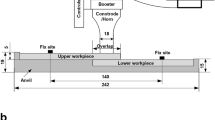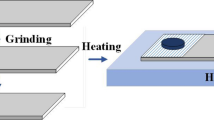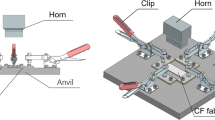Abstract
Ultrasonic welding of 4 mm thick carbon fiber/polyamide 66 (C f /PA 66) composite samples in a lap configuration was completed to characterize the effect of weld energy on weld strength. In general, it was seen that weld strength was proportional to weld energy; however, with excessive energy, the weld strength decreased. Weld indentation had little influence on joint strength, whereas thermal decomposition of C f /PA 66 composite was the main reason for the low joint strength. Higher weld energy caused thermal decomposition of C f /PA 66 composite and degradation of tensile strength of welded workpieces. A decomposition index of the joint was proposed and calculated to predict weld quality. When the decomposition index was small, joint strength increased with the weld area while high decomposition index of polyamide 66 (i.e. >30.5%) led to the decrease in joint strength based on the experimental data. The optimal decomposition index was found in the range of 12–30.5% depending on joint strength.

















Similar content being viewed by others
References
Grewell D, Benatar A (2007) Welding of plastics: fundamentals and new developments, International Polymer Processing XXII 43–60
Negin Amanat V, James NL, McKenzie DR (2010) Welding methods for joining thermoplastic polymers for the hermetic enclosure of medical devices. Med Eng Phys 32:690–699
de Costa AAP, Botelho EC, Costa ML, Narita NE, Tarpani JR (2012) A review of welding technologies for thermoplastic composites in aerospace applications. J Aerosp Technol Manag 4:255–265
Rani MR, Prakasan K, Rudramoorthy R (2009) Study of different joints for ultrasonic welding of semicrystalline polymers. J Exp Tech 33:36–42
Suresh KS, Roopa Rani M, Prakasan K, Rudramoorthy R (2007) Modeling of temperature distribution in ultrasonic welding of thermoplastics for various joint designs. J Mater Process Technol 186:138–146
Liu SJ, Chang I-T (2001) Factors affecting the joint strength of ultrasonically welded polypropylene composites. Polym Compos 22:132–141
Parmar U, Pandya DH (2016) Experimental investigation of ultrasonic welding on non-metallic material. Procedia Technol 23:551–557
Srajbr C, Tanasie G, Dilger K, Bohm S (2011) Active thermography for quality assurance of joints in automobile manufacturing. Weld World 55:90–97
Khoy Y, Chien L-h, Chang BC, Liu S-J (2000) Effects of the shape of the energy director on far-field ultrasonic welding of thermoplastics. Polym Eng Sci 40:157–167
Qiu J, Zhang G, Asao M, Zhang M, Feng H, Wu Y (2010) Study on the novel ultrasonic weld properties of heterogeneous polymers between PC and PMMA. Int J Adhes Adhes 30:729–734
Zhang G, Qiu J, Liang S, Liu M, Zhang M, Wu Y (2011) Ultrasonic weld properties of heterogeneous polymers: polylactide and poly(methyl methacrylate). J Mater Process Technol 211:1358–1363
Sun QJ, Cheng WQ, Liu YB, Wang JF, Cai CW, Feng JC (2016) Microstructure and mechanical properties of ultrasonic assisted underwater wet welding joints. Mater Des 103:63–70
Villegas IF, Rubio PV (2015) On avoiding thermal degradation during welding of high-performance thermoplastic composites to thermoset composites. Compos Part A 77:172–180
Shamey R, Sinha K (2003) A review of degradation of nylon 6.6 as a result of exposure to environmental conditions. Rev Prog Color Relat Top 33:93–107
Karstens T, Rossbach V (1989) Thermo-oxidative degradation of polyamide 6 and 6,6. Kinetics of the formation and inhibition of UV/VIS-active chromophores. Makromol Chem 190:3033–3053
Gregory Von White II, Smith JN, Clough RL, Ohlhausen JA, Hochrein JM, Bernstein R (2012) The origins of CO2 and NH3 in the thermal-oxidative degradation of nylon 6.6. Polym Degrad Stab 97:1396–1404
Villegas IF (2013) In situ monitoring of ultrasonic welding of thermoplastic composites through power and displacement data. J Thermoplast Compos Mater 28:165–185
Villegas IF (2014) Strength development versus process data in ultrasonic welding of thermoplastic composites with flat energy directors and its application to the definition of optimum processing parameters. Composite: Part A 65:27
Liu W, Zhang S, Chen X, Yu L, Zhu X, Feng Q (2010) Thermal behavior and fire performance of nylon-6,6 fabric modified with acrylamide by photografting. Polym Degrad Stab 95:1842–1848
Jain A, Vijayan K (2002) Effect of thermal ageing on Nylon 6,6 fibres. J Mater Sci 37:2623–2633
Abu Isa IA, Jodeh SW (2013) Thermal properties of automotive polymers III—thermal characteristics and flammability of fire retardant polymers. Mater Res Innov 4:135–147
Song Li, Bo Fang, Tianzhi Yang, Yewei Zhang, Lijun Tan and Wenhu Huang (2012) Dynamics of vibration isolation system obeying fractional differentiation, 84 103–108
Vijay K (1988) Stokes, analysis of the friction (spin)-welding process for thermoplastics. J Mater Sci 23:2772–2785
Peng B, Wu H, Guo S, Lai S-Y, Jow J (2007) Static ultrasonic oscillations induced degradation and its effect on the linear rheological behavior of novel propylene based plastomer melts. Polym Degrad Stab 92:1632–1639
Peng B, Wu H, Guo S, Lai S-Y, Jow J (2007) Effects of ultrasonic oscillations on rheological behavior and mechanical properties of novel propylene-based plastomers. J Appl Polym Sci 106:1725–1732
Author information
Authors and Affiliations
Corresponding author
Additional information
Recommended for publication by Commission XVI - Polymer Joining and Adhesive Technology
Rights and permissions
About this article
Cite this article
Zhi, Q., Tan, XR., Lu, L. et al. Decomposition of ultrasonically welded carbon fiber/polyamide 66 and its effect on weld quality. Weld World 61, 1017–1028 (2017). https://doi.org/10.1007/s40194-017-0482-5
Received:
Accepted:
Published:
Issue Date:
DOI: https://doi.org/10.1007/s40194-017-0482-5




